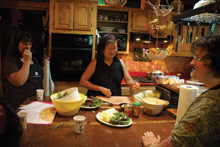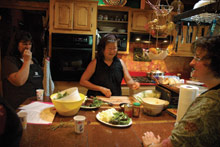There’s no shortage of Vietnamese-food fans in Asheville. But since there is a much-lamented shortage of Vietnamese restaurants, local eaters craving the inimitable cuisine have little choice but to make their own phos and sticky rice. Luna Nguyen is hoping to help them do so with panache.

Nguyen—late of At Luna’s, a Vietnamese restaurant on Biltmore Avenue that closed in 2003 just shy of its first anniversary—recently began offering cooking classes in her Leicester home. While the classes revolve around menus culled from the traditional Southeast Asian canon, the ever-hospitable Nguyen is as interested in cookery’s whys as in its hows. Her laid-back teaching sessions emphasize the camaraderie of the kitchen over classical technique.
According to Nguyen’s Web site, she aims to “reveal that good cooking is good, wholesome food that is nurturing and sustaining of love, culture and ritual.”
I attended the first of Nguyen’s classes and can attest to the relaxed atmosphere she’s cultivated. Preparing a Vietnamese meal in her Northern California-esque kitchen, with its dropped wooden ceiling, beaded curtains and window baskets piled high with garlic, felt more like helping a friend get ready for a dinner party than an official tutorial. Students were offhandedly assigned various humble tasks, from prying open cans of coconut milk to crushing peanuts with a rolling pin. They sipped licorice iced tea while Nguyen fiddled with the stove, idly chatting all the while about Southeast Asian food’s health benefits and the evils of MSG. “OK, I also need help with this,” Nguyen said repeatedly, faced with another ingredient awaiting chopping, peeling or heating.

But four hours later, there was a magnificent meal on the table. Students with little or no experience making Vietnamese food had somehow absorbed Nguyen’s casual instruction, producing platefuls of summer rolls, grilled pork and fresh cucumber relish. They’d apparently learned the building blocks of Vietnamese cuisine, soaking cellophane wrappers in water so they could easily bundle them around fresh herbs plucked from Nguyen’s garden, and boiling down a perfect nuoc mau, or caramel sauce.
“This caramel sauce can be compared to molasses, but the color is beautiful,” Nguyen counseled as the odor of burnt sugar, familiar to anyone who’s dropped a marshmallow in the campfire, filled the kitchen. “When it’s finished, it’s like this—dark like ink. Sweet, smoky, just slightly bitter.”
The caramel sauce served as a marinade for the pork shoulder, which was strung on wooden skewers. “You should be careful that you don’t make a hole in your hand,” Nguyen said. “In Southeast Asia, this is common, 10 cents a stick. It’s just like fast food, but not processed.”
Nguyen also led the class through its nuoc-cham paces, allowing students to experiment with the right ratios of garlic to vinegar to sugar for the iconic dipping sauce. “I read once—when in doubt, add fish sauce!” she laughed.
Nguyen plans to eventually tutor amateur cooks in the fundamentals of Indonesian, Burmese and Malaysian cuisines. But for now, she’s focusing on Thai and Vietnamese cookery and has five classes scheduled over the next two months, including one showcasing a diabetic-friendly menu and a course called “No Fright of Fried.” Further details are available on her newly completed Web site at www.seasiancookingeasy.com.
“Perhaps technically it is not that great,” Nguyen says of the site, “I still have to learn a lot.”
Fortunately, she also has much to teach.
Make it yourself: Vietnamese for the people
Chuoi Chung: Banana Coconut Milk Stew
Nguyen describes this dessert as a favorite street food. It was also a runaway hit at her debut class, setting all the students’ lips a-smacking. Nguyen suggests using Ladyfinger, or Nino, bananas, but long bananas will do in a pinch (To serve 6)
3 c. water
1 c. coconut milk
1 c. chopped roasted peanuts
1/3 c. pearl tapioca (Nguyen recommends the variety sold at Asian specialty stores)
1/2 c. sugar
1 lb. ripe, firm bananas
Pinch of salt
1) In a saucepan, bring water to a boil. Add tapioca, stirring to prevent sticking. Reduce the heat and cook for 10-20 minutes or until clear, stirring occasionally.
2) Add the coconut milk, sugar and salt, stirring to dissolve.
3) Peel and cut the banana diagonally into pieces measuring about 1-1/2 inches. Add to soup. Let cook for five minutes or until soft and flavors are blended.
4) Remove from heat and let cool for 10 minutes. To serve, ladle into small bowls and top with chopped roasted peanuts.
The dish can be conserved in the refrigerator for two days.
Nuoc Cham: Vietnamese Dipping Sauce
According to Nguyen, this is the sauce by which Vietnamese eaters judge a cook’s abilities. She suggests making it fresh, but it will keep for two weeks in the refrigerator. (Makes 1 1/2 cups)
1 garlic clove
3 tbs. sugar
1 tbsp. lime juice
2/3 c. water
1-3 serrano or bird chiles
1/4 c. fish sauce
1/2 tbsp. rice vinegar
1) Chop the garlic and chiles very fine, or pound them in a mortar. Start with one chile, and add more to taste.
2) Mix water, sugar, lime juice and vinegar until the sugar dissolves. Taste to balance the sweet and sour according to your own taste.
3) Add the fish sauce, starting with the recipe amount … then add more if you’d like.
4) Mix the sauce with the garlic and chiles. Set aside for 15 minutes to marinate.
Do Chua: Everyday Vietnamese Pickle
This pickle is “to the Vietnamese like sauerkraut is to the German,” Nguyen says. Served over rice vermicelli tossed with nuoc cham, it makes a lovely warm weather meal. (Makes 3 cups)
6 tbsp. sugar
2 tsp. salt
1 c. Japanese white vinegar
1 c. warm water
1 clove garlic
2 carrot
2 daikon
1) Peel carrot and daikon. Cut to thick matchsticks or use a shredder and shred into thick shreds.
2) Run the carrot and daikon with salt and 1 tbsp. sugar. Knead and mix well until it becomes wilted and reduced in size.
3) Rinse with cold water and squeeze dry.
4) Mash the clove of garlic. In a jar, mix all ingredients and stir until the sugar dissolves. Add carrot and daikon. The brine should cover the vegetables.
Let the pickle marinate for at least two hours before eating. This will keep one month in the refrigerator.



Before you comment
The comments section is here to provide a platform for civil dialogue on the issues we face together as a local community. Xpress is committed to offering this platform for all voices, but when the tone of the discussion gets nasty or strays off topic, we believe many people choose not to participate. Xpress editors are determined to moderate comments to ensure a constructive interchange is maintained. All comments judged not to be in keeping with the spirit of civil discourse will be removed and repeat violators will be banned. See here for our terms of service. Thank you for being part of this effort to promote respectful discussion.